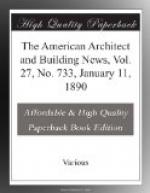Independently of the exhibit indicated by its name and character, the Palace of the Liberal Arts encloses one of the great curiosities of the Exhibition of ’89; that is the “retrospective history of labor and anthropologic science.” “The aim of this exhibit,” said M. Jules Simon, in a report which he made as the president of the Superior Commission, June 15, 1888, “is to instruct the public in the history of the processes of manual and mechanical labor, which in the passage of centuries have resulted in the modern industrial utensils used in the arts and trades.” This exhibit has a particularly historical and technical character. It is far from excluding objects of art, for in several ages the utensils, those especially which were used in the liberal arts, were veritable jewels, either from their elegance of form, or from the richness of their material, or the grace of their details. We find chefs-d’oeuvre, for instance on a geographical map, on the handle of a chisel, on the barrel of a musket. Our ancestors were not possessed with the same passion for speed and cheapness that possesses us. Industry lost, perhaps, but the arts were the gainers. The aim of the retrospective exhibition is well defined. It is to retrace with broad strokes by means of the reproductions of diagrams and authentic monuments the stages of human genius. To achieve this result it was necessary to associate with the retrospective exhibition of labor that of anthropologic science, in order to show in the outset what man was when he left the hands of nature in the different physical forms of different races. The exhibit of anthropological science and history of labor comprises then five grand divisions—first, anthropologic and ethnographic science; second, the liberal arts; third, arts and trades; fourth, means of transportation; fifth, military arts.
The central nave of the Palace of the Liberal Arts is wholly occupied by this exhibit. Grand porticos and galleries of woodwork with platforms in the lower story, form four grand divisions with interior courts that approach by monumental staircases opening under the dome upon each side of the rotunda, which occupies the centre and shelters the theatrical exhibit. All around the porticos and galleries full panels were reserved upon which M. Charles Touche placed decorative compositions broadly treated in aquarelle illustrating, so to say, the history of labor.
* * * * *
AN INGENIOUS PLAN FOR STRAIGHTENING WALLS.—Yankees, as a rule, are equal to any emergency; what the average Yankee mechanic fails to conjure up at a time when his wits are most needed, leaves very little room for foreign genius to think and work in. Yet it remained for M. Molard, a French architect, to contrive an original and ingenious plan for straightening the walls of the Conservatoire des Arts et Metiers, which threatened an absolute collapse owing to the extreme weight of the roof. A series of strong iron bars




